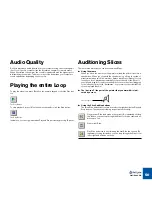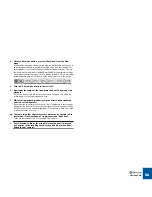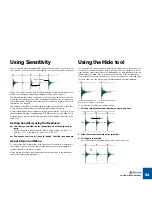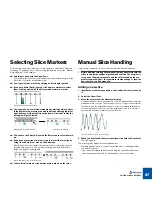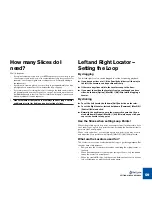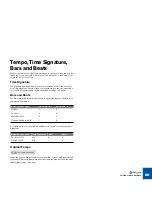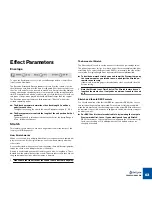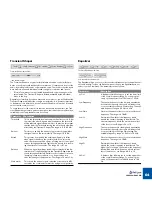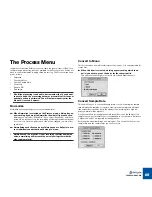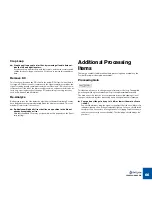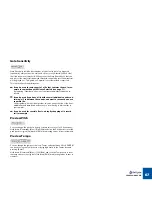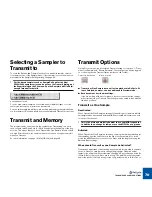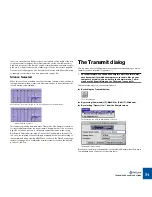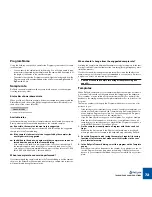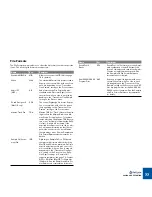
PROCESSING AUDIO
63
Effect Parameters
Envelope
To open the Envelope processor, click on the Envelope button, or select Enve-
lope from the View menu.
The Envelope Attack and Decay parameters govern how the volume of a slice
should change over time, from the time it is triggered (the slice note starts) until
the slice note ends. This can be used to make a loop more distinct (by having a
snappy attack and a short decay time) or more spaced-out (by raising the attack
time). Short attacks can also be used to mask out clicks that may occur with cer-
tain types of loops, when played back with a different tempo than the original.
The Envelope panel also features a third parameter; “Stretch”, which is de-
scribed separately below.
D
D
D
D
The Attack parameter determines the attack length (in millisec-
onds) for each slice.
The higher the setting, the slower the attack. Parameter range is 0 - 0.5 s.
D
D
D
D
The Decay parameter controls the length of the end portion (tail) of
each slice.
The more the knob is turned anti-clockwise, the shorter the decay. Range is
27ms - Infinite (=full decay).
Stretch
This feature is used when you know you might want to lower the tempo of the
loop in your MIDI sequencer.
How Stretch works
When you slice up a loop and play it back from your sequencer, each sample will
play in succession. At the original tempo, one slice will end exactly where an-
other starts.
As you understand, when you then lower the tempo, there will be small gaps be-
tween the slices, which disrupts the flow of the audio.
Stretch is used to add an extra tail of audio to each slice, to lengthen it. This is
derived from the natural decay of the sound. This extra tail of sound then fills out
the gap between the slices when the tempo is lowered.
!
Please note that the attack of the sound is not affected in any way.
The Amount of Stretch
The Stretch knob is used to set the amount of stretch as a percentage value.
The percentage values tell you how much longer the entire sample will be after
stretching. If you select the largest value (100%), for example, the slice will be-
come twice its original length when transmitted to the samplerexported.
D
D
D
D
To decide how much stretch you need, lower the Preview tempo by
the same amount as you intend to use, and adjust the Stretch pa-
rameter as necessary.
If there is a discernible gap of silence between slices you should raise the
Stretch setting.
!
Note that Stretch is not Time Stretch! The Stretch feature doesn't
lengthen the whole slice, it only adds a portion of sound to the end
of it.
Stretch and the old REX Formats
You should be aware of the fact that REX (as opposed to REX2) files can con-
tain certain settings that are irreversible. For example, if stretch was applied
when the file was saved, the stretching is part of the actual REX file and cannot
be removed. It is possible, however, to apply more stretch, which may or may not
be what you want.
D
D
D
D
For REX files it is therefore advisable to try lowering the tempo in
Preview mode first, to see if you actually need to apply Stretch.
REX2 files however, only contain the actual audio and the slices, the rest (ef-
fects, stretch setting etc.) is added when the file is loaded and can be
changed at any time.
Summary of Contents for ReCycle
Page 3: ...D D D D Table of Contents...
Page 6: ...TABLE OF CONTENTS 4...
Page 7: ...1 D D D D Introduction...
Page 10: ...INTRODUCTION 8...
Page 11: ...2 D D D D Macintosh Installation...
Page 17: ...3 D D D D Windows Installation...
Page 25: ...4 D D D D Quick Tour of ReCycle...
Page 31: ...5 D D D D Sampler Settings...
Page 36: ...SAMPLER SETTINGS 34...
Page 37: ...6 D D D D Opening and Receiving Audio...
Page 42: ...OPENING AND RECEIVING AUDIO 40...
Page 43: ...7 D D D D The ReCycle Window...
Page 51: ...8 D D D D Playing Audio...
Page 55: ...9 D D D D Setting Slices And Loops...
Page 63: ...1 0 D D D D Processing Audio...
Page 70: ...PROCESSING AUDIO 68...
Page 71: ...1 1 D D D D Transmit and Sampler Options...
Page 76: ...TRANSMIT AND SAMPLER OPTIONS 74...
Page 77: ...1 2 D D D D Saving and Exporting...
Page 82: ...SAVING AND EXPORTING 80...
Page 83: ...1 3 D D D D Example Applications...
Page 89: ...D D D D Index...


